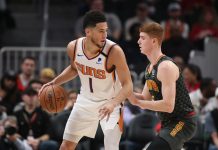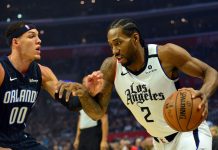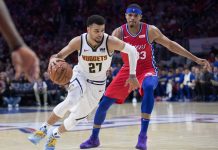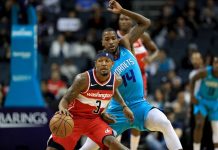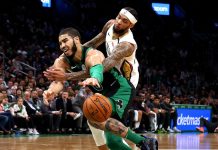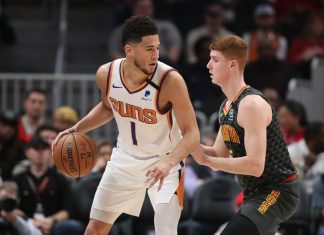INDIANAPOLIS (AP) Basketball Hall of Famers George Gervin and George McGinnis see a lot of their old league in today’s NBA.
Their former teammates notice it, too.
Five decades ago, they were the guys running the floor, embracing the 3-pointers and welcoming underclassmen. They understood the entertainment value of high-scoring games, dunk contests and halftime shows. They valued rivalries, camaraderie and the sense everyone in the sport was working toward a single goal.
Today the business model first adopted by the American Basketball Association has largely become the standard operating procedure for the world’s biggest basketball league.
”When the merger happened, we knew the NBA was going to have a strong foundation,” Gervin said Saturday in Indianapolis. ”People talk about how Magic (Johnson) and (Larry) Bird saved the NBA. I think it’s ludicrous because we gave the NBA an infusion of excitement that made the league fun again.”
Just about any player in town for the league’s 50-year reunion knows the truth.
Aside from the league’s trademark red, white and blue basketball that served as a center piece for the dinner, just about everything else the league innovated with has eventually made its way to its rival league.
Some of it was borne out of necessity.
Most ABA teams lacked the size or the star power of the more established NBA, so they relied on tempo, showmanship and pizazz to attract fans. Gervin earned the nickname ”Iceman” in San Antonio. Julius Erving became better known as ”Dr. J.”
Playoff series got nicknames, too, and there were times the backstories seemed as every bit as wild as the social culture of the 1960s and 1970s.
”The league had to have an identity,” Gervin said. ”You call it wild. I call it fun.”
The biggest secret was that amid all the fanfare, there was some darn good basketball being played.
Numerous former ABA stars including Erving, Rick Barry, Moses Malone have been inducted into the Hall of Fame. So has Spencer Haywood, one of the sport’s most important pioneers.
Haywood became the first underclassmen to declare he was leaving school after his sophomore season at the University of Detroit and was shunned by the NBA, prompting a Supreme Court case Haywood would eventually win in 1971.
The NBA still balked.
”It set the tone for a lot of things that are happening today,” said McGinnis, another underclassman who joined the ABA’s Pacers after turning pro. ”Roger Brown and Connie Hawkins weren’t allowed to play in their prime in the NBA because they got blackballed by the NBA. And Roger didn’t get to play at all because he was 28 or 29 when he came to the Pacers. But it was those type of guys who laid the foundation for guys like myself and those who are entering the league today.”
Haywood was back in Indy, too, enjoying he stories and seeing old friends.
He also was here for a purpose. While the Dropping Dimes Foundation, which put on the reunion, is trying to help provide health care for former ABA players, Haywood has taken it a step further.
As the new chairman of the board for the NBA’s Retired Players Association, he is putting on a full-court press to advocate bringing players from the now defunct league into the NBARPA’s health insurance policy. The league’s current players contribute more than $16 million to the fund.
”We have about 100 or 150 players who don’t have much, so my mission now is to get all of the ABA players covered with health insurance,” he said. ”And I know they (the current) players will take care of it.”
But this night was a celebration.
With highlight reels playing over and over, many old players donning their shiny championship rings and the Pacers bringing out one of their three championship trophies, the talk inside Bankers Life Fieldhouse was more about satisfaction that the league had accomplished something many doubted it could.
”You look at everything, you look at the halftime events, that’s all from us,” Haywood said. ”The 3-point contents, the dunk contests that was all us. It’s all ABA, baby.”
25% Bonus via Western Union


